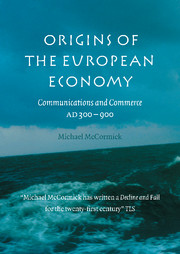Book contents
- Frontmatter
- Dedication
- Contents
- List of maps
- List of figures
- List of tables
- List of charts
- Preface
- List of abbreviations
- Commerce, communications, and the origins of the European economy
- PART I THE END OF THE WORLD
- PART II PEOPLE ON THE MOVE
- PART III THINGS THAT TRAVELED
- 10 Hagiographical horizons: collecting exotic relics in early medieval France
- 11 “Virtual” coins and communications
- 12 Real money: Arab and Byzantine coins around Carolingian Europe
- Things that traveled
- PART IV THE PATTERNS OF CHANGE
- PART V COMMERCE
- Appendices
- Bibliography
- Index
11 - “Virtual” coins and communications
from PART III - THINGS THAT TRAVELED
Published online by Cambridge University Press: 05 February 2015
- Frontmatter
- Dedication
- Contents
- List of maps
- List of figures
- List of tables
- List of charts
- Preface
- List of abbreviations
- Commerce, communications, and the origins of the European economy
- PART I THE END OF THE WORLD
- PART II PEOPLE ON THE MOVE
- PART III THINGS THAT TRAVELED
- 10 Hagiographical horizons: collecting exotic relics in early medieval France
- 11 “Virtual” coins and communications
- 12 Real money: Arab and Byzantine coins around Carolingian Europe
- Things that traveled
- PART IV THE PATTERNS OF CHANGE
- PART V COMMERCE
- Appendices
- Bibliography
- Index
Summary
In 1961, Polish archaeologists must have disrupted the flow of tourists from the vaporetti, the local water buses, to the splendid Byzantine mosaics of Torcello. The eleventh-century church on this island marks one of the oldest settlement centers of early medieval Venice. The church itself was rebuilt from a structure which, to judge from an inscription, the Byzantine governor had dedicated in 639. Right next to the church, the Poles sank a sounding trench into the early medieval market square. This must be the very place that a tenth-century Byzantine emperor called the “great market.”
Among the objects that emerged from the mud were two damaged coins which had fused together (Figure 11.1). They still bore the imprint of the textile bag in which they had been lost over a thousand years previously. One was a silver penny (denarius) issued at Milan by Charles the Great between 793 and 812. The other coin was more badly damaged. But one can still make out its Kufic inscription: “There is no God but Allah …” It was a silver dirham, issued in the Abbasid caliphate around 800. How did these coins come together at this place, in this time? What does their story tell us about the broader one of communications and commerce in the world of Charlemagne?
Solving the small riddle of the coins from the Venetian marketplace will take us a step closer to a much greater enigma, the origins of the European commercial economy.
- Type
- Chapter
- Information
- Origins of the European EconomyCommunications and Commerce AD 300–900, pp. 319 - 342Publisher: Cambridge University PressPrint publication year: 2002



